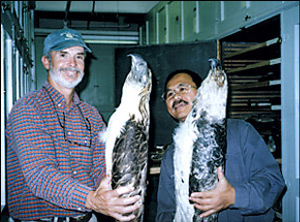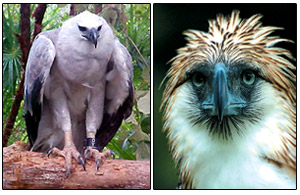Norita Scott-Pezett of Audubon-Panama, a fellow BirdLife International Global
Council member (1999-2004), was shocked when I told her that, as far as I know,
their Harpy Eagle (Harpia harpyja) is the largest eagle in the world! “What?”
she responded incredulously. “I thought all along that your Philippine
Eagle (Pithecophaga jefferyi) is the largest in the world!” Huh? Really?
Since then I started to doubt what I used to know and gladly suspected that
she was right. I began to believe that the Haring Ibon is the largest eagle
in the world even without any solid basis yet, save for my hazy recollection
of two specimens displayed in the Smithsonian Museum at Washington, D.C.
Who or what authority proclaims which eagle is the largest in the world, anyway?
What would be the basis? I personally had no access to any documents about it.
Or perhaps, I was not looking hard enough in the right places.
Then on September 26, 2004, Haribon Executive Director Anabelle Plantilla and
I had a meeting with Dr. Robert Kennedy at the Harvard University Museum of
Natural History in Boston. (Dr. Kennedy is the principal author of the book
A Guide to the Birds of the Philippines. He has extensively studied the Haring
Ibon with excellent video documentation. He is a founding member of the Haribon
Foundation).
 |
| The
author compares an eagle specimen with Dr. Robert Kennedy
of the Harvard Museum of Natural History |
|
|
After a discussion on fund-raising strategies for Haribon, Bob showed us some
Philippine bird specimens. And naturally, the Haring Ibon was the first of those
specimens! I found myself asking which is larger between the Philippine Eagle
and the Harpy Eagle. To my pleasant surprise, Bob believes that our Haring Ibon
or Philippine Eagle is the largest eagle in the world!
“The term largest can have different meanings,” he said while pulling
out and handling the specimens one by one like a delicate baby. “The Harpy
Eagle maybe the largest in terms of bulk or weight, but the Philippine Eagle
is the largest in terms of wingspan and height.” There you go—confirmation
from no less than Dr. Kennedy!
Bob had a few large specimens of the Harpy and the Haring Ibon to compare before
us.
Excitedly, Anabelle took pictures. That did it! The Haring Ibon really is the
largest eagle in the world! “But easy, Blas,” I cautioned myself, “pictures
are not enough proof!” I eagerly wanted to start doing some measurements but
Bob’s wife Ann was already waiting for us at the parking lot. “Wait until you
get to Chicago in three weeks,” I consoled myself yet hardly willing to wait
that long.
Finally, I got my chance. David Willard, Bird Collections Manager of the Field
Museum, graciously led me to steel cabinets number 45 and number 46. He unlocked
them and pulled out two large trays with three Harpys on one and two Haring
Ibon on the other. “There are two other specimens upstairs, one of each.
You can look at them as well, after you’re done with these,” he
said and left me to establish proofs for my thesis.
The specimens were vintage collections dated 1953, 1959, and 1960 (Table 1).
One problem I had to deal with was that the only information available on the
species were notes on the specimen labels, which lacked important external measurements.
When I asked David whether I could get more information from the catalogue,
he said “What you see on the labels are what we have in the catalogue.”
I took several photos of the specimens. Then, I started measuring them. The
bill, tarsus, talon, and wing measurements were relatively easy. The total length
measurements (from the tip of the bill to the tip of the longest tail feather)
were tricky because the skins could have been prepared to be bigger or smaller,
longer or shorter than they actually were depending on the taxidermist who prepared
them. But since there was no other way to do it, I just had to do it as best
as I could and hoped the variances or errors were not that significant. The
tail length could not be measured because I would risk damaging the specimens
if I did it.
When I pulled out the tray containing the two specimens from the cabinet upstairs,
large eagle specimens of other species (Golden Eagle, American Bald Eagle, and
a Kenyan Eagle) were on the same tray. I decided to measure them too. At the
end of the day, I shared my findings with Dr. Larry Heaney of The Field Museum,
Chicago and Danilo Balete of Laksambuhay. Not surprisingly, Larry and Danny
concurred that there are ways of interpreting what “largest” means. The Harpy
Eagle may be the heaviest eagle in the world but certainly the Haring Ibon is
the largest eagle in the world based on the documented measurements that I gathered
from the available specimens at the Field Museum.
 |
Which
is the larger eagle? The harpy or the haribon? Comparing raptor notes.
|
|
|
The raw data are shown on Table 1. Based on a very limited available number
of specimens and selected external measurements, we have the following:
Total Length (from tip of bill to tip of longest tail feather):
1. Haring Ibon (average) = 1021 mm or 1.021 meter
2. Harpy Eagle (average) = 900.75 mm or 0.90075 meter
3. Golden Eagle (single) = 884 mm
4. Kenyan Eagle (single) = 855 mm
5. American Bald Eagle (single) = 829 mm
Bill Gape
1. Haring Ibon = 73.66 mm
2. American Bald Eagle = 71 mm
3. Harpy Eagle = 64.75 mm
4. Golden Eagle = 60 mm
5. Kenyan Eagle = 55 mm
Bill Culmen
1. Haring Ibon = 72.33 mm
2. Harpy Eagle = 51 mm
3. American Bald Eagle = 50 mm
4. Golden Eagle = 45 mm
5. Kenyan Eagle = 45 mm
Bill Height
1. Haring Ibon = 50.66 mm
2. Harpy Eagle = 36 mm
3. American Bald Eagle = 33 mm
4. Kenyan Eagle = 33 mm
5. Golden Eagle = 27 mm
Tarsus (Foot length)
1. Haring Ibon = 145 mm
2. Harpy Eagle = 121.25 mm
3. Kenyan Eagle = 115 mm
4. Golden Eagle = 110 mm
5. American Bald Eagle = 95 mm
Talon (Hind toe claw)
1. Harpy Eagle = 64.75 mm
2. Kenyan Eagle = 62 mm
3. Haring Ibon = 55.66 mm
4. Golden Eagle = 55 mm
5. American Bald Eagle = 39 mm
Wing Chord
(from bend or shoulder to tip of longest primary feather)
1. Golden Eagle = 654 mm
2. Haring Ibon = 608.66 mm
3. American Bald Eagle = 570 mm
4. Kenyan Eagle = 545 mm
5. Harpy Eagle = 544.75 mm
The Haring Ibon tops in 5 of the 7 external measurements, namely, total length,
bill gape, culmen, bill height and tarsus. The Harpy tops in 1 out of 7 measurements,
namely the talon. In the wing measurement or wing chord, Haring Ibon is only
second but Harpy Eagle is fifth.
Well, this is just a simple exercise to illustrate that we now have a basis
for proclaiming that “Haring Ibon or the Philippine Eagle is the largest
eagle in the world.”
The Harpy Eagle is the “heaviest eagle in the world,” at least
one book says so (i.e. Cambridge Encyclopedia of Ornithology (1991)). But we
have nothing on hand in terms of data. Surely, there are ways of getting some
information on the weight of the Harpy Eagle. This could be done later. And
perhaps, it may be nice to check from our friend Dennis Salvador of the Philippine
Eagle Foundation if they have data on the Haring Ibon in terms of weight. Who
knows what the data might reveal?
Photos by Alejo P. Manaloto
Illustrations by Oscar Figuracion Jr.
Photo of harpy eagle taken from belize zoo website
Notes about the author
Blas Tabaranza Jr. is Director of the Terrestrial Ecosystems Program of the Haribon Foundation. He is a Professor of Zoology at the Mindanao State University-Iligan Institute of Technology with extensive field experience in ornithology and mammalogy. He was the first president of the Wildlife Conservation Society of the Philippines (1993-2000) and a research associate of the Chicago Field Museum of Natural History.
This article was republished with permission from Haribon Foundation website
|
|
 |
|
LAKBAY PILIPINAS ONLINE HOTEL RESERVATION
Book online or call: +1 972-894-1181, World Wide Direct Within USA or
Canada Toll Free: 1-888-254-0637 Give Promo Code 6066 when calling.
Email: RESERVATIONS@lakbaypilipinas.com
|
 |
|
|
Make
LAKBAY PILIPINAS your Homepage
LakbayPilipinas.com - is one of the best and largest online hotel reservation website - we have every kind of lodging including Bed and Breakfast, backpacker hostels, cheap hotels, discount motels, discount hotels, and luxury 5-star accommodation all over the Philippines and the rest of the World! Our goal is to offer the widest hotel directory with the best hotel deals and discount rates as well as a convenient, fast and secure way to make a hotel booking.
|
|
 |
|
